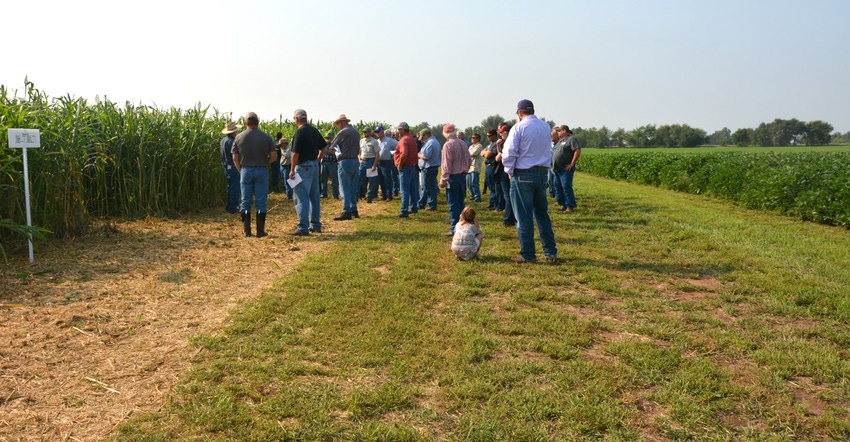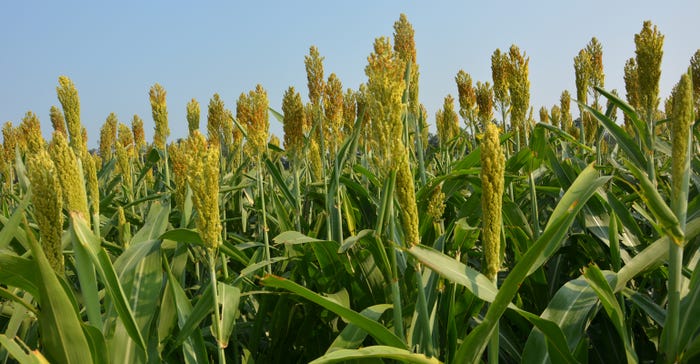
What succeeds and what fails when you are trying to improve the health and life of your soil can only be determined by trial and error, a panel of producers told attendees at a Soil Health Field Day sponsored by Kauffman Seed, the Cheney Lake Watershed conservation group and the Reno County Natural Resources Conservation Service.
Panelists included Jeff Brawner, who grows corn, milo, soybeans and cover crops north of Haven; Chad Basinger, who grows wheat, milo, soybeans and cover crops near Pretty Prairie; and Derek Zongker, who farms in the Sylvia area. Professional cover crop coach Steve Groff moderated the discussion.
Zongker said he has been no-till farming for about a decade and started growing cover crops about six years ago. He urged farmers who want to get started in cover crops to attend a field day in their area, find a mentor and start in the fall with a simple mix of covers.
"I think I had more failures than I did successes when I first started out," Zongker said. "Failures like the year that my cover crops never came up because of residual herbicide in the field from the previous crop. You learn from the failures."
Zongker said he has found success with companion cropping cow peas and soybeans, and with adding cattle to the mix.
"When you are looking for diversity, cattle offset the cost of seed to plant the cover crops," he said.
Groff agreed that adding cattle to the program will help cover crops pay off, and the kind of cover crops you plant can help promote livestock health as well as soil health.
 SORGHUM CROP: A demonstration field of sorghum is looking good at the Kauffman Seed facility near Hutchinson.
SORGHUM CROP: A demonstration field of sorghum is looking good at the Kauffman Seed facility near Hutchinson.

Basinger said he is convinced that the best soil health comes from diversity, and that his goal is to keep roots alive in the soil 100% of the time.
Brawner said experimenting is an important part of the process, and that farmers can take direction by observing what grows well and what doesn't do so well.
Zongker said he has had good results from planting cover crops on acres that he plans to sow back to wheat in the fall and grazing cattle on the covers.
"Compaction hasn't been an issue for me with the exception of the area right around water tanks," he said. "What has worked best for me is to crimp and roll the cover crop and plant into the residue. Your need for herbicide goes way down."
Another speaker at the event was Keith Thompson, who farms near Osage City in an area that has been hit by exceptional drought this year. He has been no-tilling since 1991 and said the benefit he has seen from dry weather has been the disappearance of root diseases.
"I've done covers before and after grain crops, and I have even tried planting covers while the crop is still growing," Thompson said. "Initially, I didn't get good emergence, and I found the answer was more down pressure on the air seeder to get the seed into the ground."
 DROUGHT IMPACT: Keith Thompson, who farms near Osage City, shares what he has learned about cover crops, weed suppression and root diseases during a summer of exceptional drought.
DROUGHT IMPACT: Keith Thompson, who farms near Osage City, shares what he has learned about cover crops, weed suppression and root diseases during a summer of exceptional drought.

He added that he has gone to spiked wheels and learned that it is important to keep opening blades in good shape.
"I have a buddy who lost three bushels to the acre because of bad blades," he said. "On his entire field, that was a $9,000 loss. New blades would have cost $600. So yes, blades are well worth it."
Thompson said cover crops that mimic nature's biodiversity provide a variety of benefits such as weed control, erosion control, recycling of nutrients, control of nematodes and fungal diseases, improvement in soil structure, and attraction of beneficial insects.
"Nature likes to have living roots in the soil. I tell people who can, either plant and grow what you want to have growing or nature will cover the ground for you," he said. "You don't have to lock into a plan, you can let what you need in the way of forage govern what you plant."
Thompson, too, advised adding livestock to the cropping operation.
"When you add forage crops to the grazing available, you can extend permanent pasture grazing," he said. "You also get higher yields of grain crops when they are planted behind perennials. When you start with cover crops and animals, you will see changes in three years and major changes in 10 years."
In demonstration field tours during the event, Kaufmann Seed co-owner Tom Clayman said the secret to continuously improving soil health is to keep trying something new.
"Constantly trying new crops helps you find the crops that will grow well at the time you want them to grow," Clayman said. "If you keep growing the same things, you end up with the same microbes in the soil and the same root mass. That doesn't make for progress."
 TALKING COVERS: Tom Clayman, co-owner of Kauffman Seed, shares his wisdom on cover crop mixes with visitors at a Soil Health Day.
TALKING COVERS: Tom Clayman, co-owner of Kauffman Seed, shares his wisdom on cover crop mixes with visitors at a Soil Health Day.

Clayman told field day attendees that gaining root mass is one way to gain healthier soil, and that means trying cereal crops that have larger root systems.
"Wheat root mass is about the size of one fist," he said. "Barley is two fists. Triticale is three fists and cereal rye is close to six fists."
At Kauffman's demonstration plants, a variety of cover crops are grown together.
Clayman said that he likes to use buckwheat in the cover mix because earthworms love buckwheat root, but a combination of seed and forage crops is ideal for cover crops that can provide good grazing for livestock at the same time they build soil health.
"One key is to make sure that you plant you plant enough seed, so the crops choke out the weeds," he added. "Another thing is to look for crops that help you solve insect problems. If you've had problems with sugar cane aphids, for example, you can plant a sudangrass that is highly
About the Author(s)
You May Also Like




